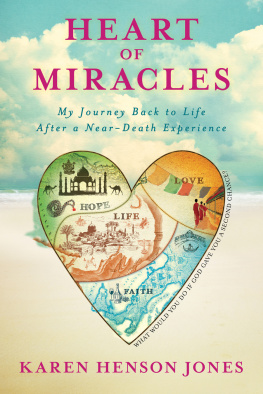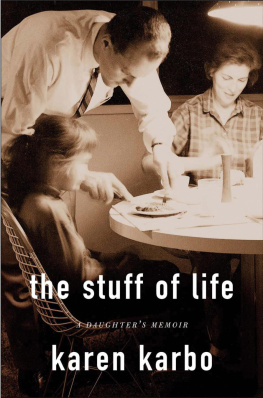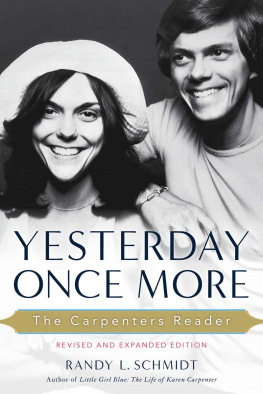
Evelyn McDonnell
Series Editor
WHY KAREN CARPENTER MATTERS
Karen Tongson

UNIVERSITY OF TEXAS PRESS
AUSTIN
Copyright 2019 by Karen Tongson
All rights reserved
First edition, 2019
Project editors: Lynne Chapman and Amanda Frost
Cover design: Amanda Weiss
Typeset in Knockout and Fournier by Dustin Kilgore
Book cover printed by Phoenix Color, interior by Sheridan Books
Requests for permission to reproduce material from this work should be sent to:
Permissions
University of Texas Press
P.O. Box 7819
Austin, TX 78713-7819
utpress.utexas.edu/rp-form
Library of Congress Cataloging-in-Publication Data
Names: Tongson, Karen, author.
Title: Why Karen Carpenter matters / Karen Tongson.
Description: Austin : University of Texas Press, 2019. | Series: Music matters
Identifiers: LCCN 2018039812
ISBN 978-1-4773-1884-3 (pbk. : alk. paper)
ISBN 978-1-4773-1885-0 (library e-book)
ISBN 978-1-4773-1886-7 (non-library e-book)
Subjects: LCSH: Carpenter, Karen, 1950-1983. | SingersUnited StatesBiography.
Classification: LCC ML420.C2564 T65 2019 | DDC 782.42164092dc23
LC record available at https://lccn.loc.gov/2018039812
doi:10.7560/318843
To Jos Esteban Muoz (19672013)
for pointing me to the queer horizon
CONTENTS
PREFACE
Unlike many other young icons of rock and pop lost to overdoses under dramatic circumstances, from Janis Joplin to Jimi Hendrix to Jim Morrison, Karen Carpenter faded out slowly, just like the music she and her brother, Richard, were known for making together as the Carpenters. One might even describe her death in 1983 as a protracted suicide aided by her underconsumptionthe refusal to eat and nourish her bodyas opposed to the raucous excesses and overconsumption so characteristic of other rock stars stories of demise. In this book, I revisit the events of Karens life and death, not in an effort to retrace history or to speculate on how this could have happened, but instead to explore the different afterlives generated by her music and her voice in far-flung settings, including in our fantasy worlds. Karen Carpenter matters, I argue, because she transformedbecause we transformedthe uneventful in her life, work, and even death into something extraordinary.
Volumes of workbiographies, academic articles, think pieces before such things as think pieces existedhave been devoted to the Carpenters, the brother-sister duo whose storied rise to the top of the charts, and the top of the world, coincided with Richard Nixons America and a worldview that staunchly held on to an attitude of Sunbelt optimism, despite the international and domestic turmoil caused by the Vietnam War. Why Karen Carpenter Matters delves into some of the scenes of the Carpenters suburban upbringing while bringing an international outlook to their story and their musical body of work. I focus on Karen Carpenter, and not the duo known as the Carpenters, precisely because it is Karens iconicitydue in no small part to her tragic, early death and haunting contralto voicethat resulted in their musics enduring appeal in the United States and abroad. This book delves not only into the bands movements through time and space, but more specifically into the myths surrounding Karen Carpenters voice, which eventually became reanimated through other bodies and other voices, in the Philippines (my birthplace) and elsewhere, through brown bodies, queer bodies, differently abled bodies.
All this said, this book is not a comprehensive biography or even an extended social history about Karen or the Carpenters and every album they recorded or every venue where they may have performed. There are lengthier, more extensive volumes to turn to for that level of thoroughness. Instead, this book, like so much of my other work, is inspired by something the Victorian aesthete and writer Walter Pater once wrote in the preface to his 1873 book The Renaissance. He asks, What is this song or picture, this engaging personality presented in life or in a book, to me? What effect does it really produce on me?
A good portion of this book is devoted to answering Paters questions about music, lives, and engaging per and her voice and music are coordinates in the musical mapping of my familys journeys across the Pacific, between big cities like Manila and the sprawl of Southern California, and between old-fashioned notions of romance and the queer desires that come to the surface despite the Carpenters milquetoast musical fantasies about normal love.
Karen Carpenter matters to me because I was nurtured on the idea that my mother, who is also a singer, sounded like Karen Carpenter. My mother christened me Karen when I was born in Manila, five years before we sought our fortunes in the United States for the first time. Karen Carpenter is, at once, my blessing and my burden.
The Philippines is often depicted as a kind of sonic mirror of the United States because of its robust history of cover bands who imitated American pop styles ever since the US liberated the island nation in World War II. The relationship between American and Filipino pop culture is an intimate one because of the US military presence in the country and the influence of media like the Armed Forces Radio on the nations taste and entertainment culture.
Karen Carpenter matters to Filipinos and Filipino Americans like me, whose movements through the megalopolis of Manila, to and from the Philippines rural provinces, and eventually to distant places for overseas labor, are scored to Karens voice: one redolent of tears, even when she sings about unbridled joy. Why Karen Carpenter Matters, in other words, is not about why others have thought the Carpenters mattered as an American pop group who helped spawn soft rock (though this fact is of the utmost importance), or as the most avowedly goody-four-shoes pop act to rule the charts. Instead, Why Karen Carpenter Matters is about why Karen matters to people of color, immigrants, queer people, gender outlaws, and everyone other than the white Nixon-era suburbanites she and her music are said to have represented. In order to make this case, the book reaches through and between real and conjured histories, memories false and true, born of cross-cultural tales of affection, aggression, and an abiding longing.
Why Karen Carpenter Matters will move between the Southern California suburbs, where the duos signature Spectrum sound was cultivated amidst chain stores and defense plants (like the one Agnes Carpenter, Karens mother, worked in), and the Philippines, where I was bestowed with the name Karen. Southern Californias suburbs became my own familys destination, inspired in part by a dream of yesterdays once morethe radio traces of a good life that has since receded into memory, or perhaps never was. Combining memoir with history, critical and creative geographies, musical analysis, queer theory, and on occasion, self-analysis, Why Karen Carpenter Matters explores the ties that bind artists and listeners beyond families and fandoms.
WHITENESS AND PROMISES
On February 4, 1983, Karen Carpenter died of complications from anorexia nervosa while she was reaching for a fuzzy bathrobe in the bedroom closet at her parents mid-century suburban home in Downey, California. By all accountsRay Colemans 1994 biography chief among themKaren spent the day before she died cruising between suburban chain stores, looking for sturdy household items like a washer-dryer at the Downey Gemco, a big-box store absorbed by Target in the mid-1980s that she affectionately referred to as the Gucci of Downey. She ate a shrimp salad for dinner with her parents at Bobs Big Boy and picked up a couple of tacos to go from a local joint next door so she could snack on them while indulging in the made-for-TV spectacle of a manscaped, micro-kimono-clad Richard Chamberlain in
Next page











